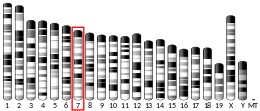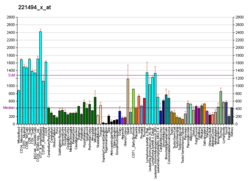EIF3K
Protein-coding gene in the species Homo sapiens From Wikipedia, the free encyclopedia
Eukaryotic translation initiation factor 3 subunit K (eIF3k) is a protein that in humans is encoded by the EIF3K gene.[5][6][7]
| EIF3K | |||||||||||||||||||||||||||||||||||||||||||||||||||
|---|---|---|---|---|---|---|---|---|---|---|---|---|---|---|---|---|---|---|---|---|---|---|---|---|---|---|---|---|---|---|---|---|---|---|---|---|---|---|---|---|---|---|---|---|---|---|---|---|---|---|---|
| |||||||||||||||||||||||||||||||||||||||||||||||||||
| Identifiers | |||||||||||||||||||||||||||||||||||||||||||||||||||
| Aliases | EIF3K, EIF3-p28, EIF3S12, HSPC029, M9, MSTP001, PLAC-24, PLAC24, PRO1474, PTD001, ARG134, eukaryotic translation initiation factor 3 subunit K | ||||||||||||||||||||||||||||||||||||||||||||||||||
| External IDs | OMIM: 609596; MGI: 1921080; HomoloGene: 8292; GeneCards: EIF3K; OMA:EIF3K - orthologs | ||||||||||||||||||||||||||||||||||||||||||||||||||
| |||||||||||||||||||||||||||||||||||||||||||||||||||
| |||||||||||||||||||||||||||||||||||||||||||||||||||
| |||||||||||||||||||||||||||||||||||||||||||||||||||
| |||||||||||||||||||||||||||||||||||||||||||||||||||
| |||||||||||||||||||||||||||||||||||||||||||||||||||
| Wikidata | |||||||||||||||||||||||||||||||||||||||||||||||||||
| |||||||||||||||||||||||||||||||||||||||||||||||||||
Function
The ~800 kDa eukaryotic initiation factor 3 (eIF3) is the largest eIF and contains at least 12 subunits, including eIF3k/EIF2S12. eIF3 plays an essential role in translation by binding directly to the 40S ribosomal subunit and promoting formation of the 43S preinitiation complex.[8][7]
Interactions
eIF3k has been shown to interact with Cyclin D3[9] and eIF3a.[6][10]
See also
References
Further reading
External links
Wikiwand - on
Seamless Wikipedia browsing. On steroids.







